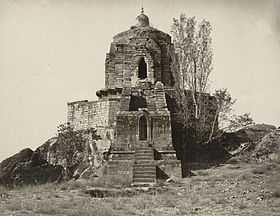Shankaracharya Temple
| Shankaracharya Temple | |
|---|---|
 Shankaracharya temple | |
 Shankaracharya Temple Location in Jammu and Kashmir
| |
| Coordinates: | 34°4′44″N 74°50′37″E / 34.07889°N 74.84361°ECoordinates: 34°4′44″N 74°50′37″E / 34.07889°N 74.84361°E |
| Name | |
| Other names: | Jyesteshwara temple, Pas-Pahar |
| Location | |
| Country: | India |
| State: | Jammu and Kashmir |
| District: | Srinagar |
| Location: | Srinagar |
| Elevation: | 1,852.16 m (6,077 ft) |
| Temple Details | |
| Primary Deity: | Shiva |
| Architecture and culture | |
| Number of temples: | 1 |
The Shankaracharya Temple (Kashmiri: शंकराचार्य मंदिर (Devanagari), شنکراچاریہ مندر (Nastaleeq)), also known as the Jyesteshwara temple or Pas-Pahar by Buddhists, is situated in the Zabarwan Mountain in Srinagar, Kashmir. It is dedicated to Lord Shiva. The temple is on the summit of the same name at a height of 1,000 feet (300 m) above the plain and overlooks the city of Srinagar. The hill is also referred to as Takht i Suleiman (Throne of Solomon) and the temple also called "Throne of Solomon."[1][2] It is believed that king Solomon came to worship on the hill which makes the place sacred from ancient times.
History & development
The temple dates back to 200 BC, although the present structure probably dates back to the 9th century AD. It was visited by Adi Shankara and has ever since been associated with him; this is how the hill/temple got the name Shankaraharya. It is also regarded as sacred by Buddhists. The Shiv ling was placed inside by Adi Shankaracharya on his visit to Kashmir; it became a Hindu temple.[3]
According to Pandit Anand Koul (1924) the temple was originally built by "Sandiman" (unknown) who, according to Koul, reigned in Kashmir from 2629 to 2564 BC.[4] It was repaired by King Gopaditya (426–365 BC) and by King Lalitaditya (697–734).[4] Its roof was also repaired by Zain-ul-Abidin after an earthquake; later, its dome was repaired by Sheikh Ghulam Mohiuddin, a Sikh governor (1841–1846).[4]
Architechture & design
The Jyoteshware temple rests on a solid rock. A 20 feet hight octagonal base supports a square building on top. The terrace around the square temple is reached by a stone staircase enclosed between two walls.[5]A doorway on the opposite side of the staircase leads to the interior, which is a small and dark chamber, circular in plan. The ceiling is supported by four octagonal columns, which surround a Basin containing a Lingam encircled by a snake.[6]
Current Status
The temple is used for regular worship & pilgrims visit the temple during the Amarnath Yatra.[7]
References
- ↑ Gladys D. Clewell, Holland Thompson Lands and peoples: the world in color 1947 - Volume 4, Page 111 "On the Throne of Solomon is a magnificent temple of stone, said to have been founded in extremely ancient times, although the present buildings are probably not more than four hundred years old"
- ↑ Trudy Ring, Noelle Watson, Paul Schellinger Asia and Oceania: International Dictionary of Historic Places - 2012 "Solomon's Throne. See Shankaracharya Hill, Srinagar"
- ↑ Jammu, Kashmir and Ladakh: Tourist Guide. Akashdeep Publishing House. Retrieved March 25, 2007. "The Buddhists still regard this temple sacred and call it Pas-Pahar."
- ↑ 4.0 4.1 4.2 Jammu, Kashmir and Ladakh: Tourist Guide. Akashdeep Publishing House. Retrieved March 25, 2007. "Pandit Anand Koul records that it was originally built by Sandiman, who reigned from 2629 to 2564 BC. It was repaired by King Gopaditya (426–365 BC) and by King Lalitaditya (697–734 A.D.). Sikandar, the Iconoclast did not, for some reason, destroy it. Zain-ul-abidin repaired its roof which had tumbled down by earthquake. Sheikh Ghulam Mohi-ud-din, a Sikh Governor (1841–46), also repaired its dome."
- ↑ "Kashmir. Temple of Jyeshteswara [Shankaracharya], on the Takht-i-Suliman Hill, near Srinagar. Probable date 220 B.C.". British Library. Retrieved 07 December 2013.
- ↑ "Kashmir. Temple of Jyeshteswara [Shankaracharya], on the Takht-i-Suliman Hill, near Srinagar. Probable date 220 B.C.". British Library. Retrieved 07 December 2013.
- ↑ "Amarnath Pilgrims reach Shankaracharya Temple". www.hindustantimes.com. 22 July 2009. Retrieved 7 December 2013.
External links
| |||||